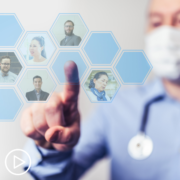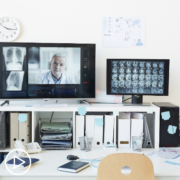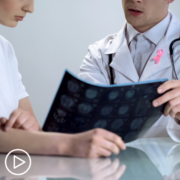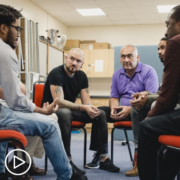How Is Personalized Medicine in MPN Care Influenced by Telemedicine?
How Is Personalized Medicine in MPN Care Influenced by Telemedicine? from Patient Empowerment Network on Vimeo.
How is MPN personalized medicine impacted by telemedicine? Watch as expert Dr. Jeanne Palmer shares situations where personalized care can aid essential thrombocythemia, myelofibrosis, and polycythemia vera patients, how telemedicine can aid in care, and the value of specialized care.
See More from MPN TelemEDucation
Related Resources:

|

|

|
Transcript:
Dr. Palmer:
So I think one of the key…so when we look at treating different myeloproliferative neoplasms, you have to take what’s your goal of therapy. So for the ones like essential thrombocythemia, where you have too many platelets, or polycythemia vera, where there’s too many red cells. A lot of times what you’re doing there is you’re just saying, “Well, how can I predict whether you’re going to have a blood clot or something?” Because people can live, these can be fairly chronic diseases that with appropriate therapy, people can live a long time.
So a lot of that’s risk mitigation. Where I think a lot of the personalized aspect of it is coming in is probably in myelofibrosis, which is a disease where I view it as too much inflammation, scar tissue develops in the bone marrow, people could get a large spleen, high white blood cell count. A number of different manifestations. And in that, we’re learning more and more that in addition to the three driver mutations, the JAK2, the MPL, and the calreticulin, there’s probably a whole other group of mutations that can really be used to help us predict and try to take a look into the future to help guide them. And what is the timing for transplant? Should we be more aggressive as we’re getting more and more agents being evaluated and hopefully approved in the treatment of myeloproliferative diseases? Who are the people who should utilize these agents?
Because again, you don’t want to overtreat. And so I think that being able to hone in on these different mutations to be able to help us predict what we think will happen and maybe different treatment options that we would have, that’s going to be important. Now, one of the things that’s really exciting is that some of these companies that actually do this deep sequence, like looking at multiple, multiple genes, actually have mechanisms by which they will send somebody to a person’s house and then draw the blood and take it over and run it. And so I’ve actually had that done before, where somebody I saw via telemedicine, and we really wanted to get that information so I could appropriately advise on what I anticipated was going to happen in the course of the disease.
And we were able to actually get that information through using home care, saying, “I want this order to be done. The home care people went out, drew the blood, sent it to where it needed to go in the right format, and I was able to get that information.” So I think that telemedicine allows them access to people who understand how to interpret that information. But I think we have to give a lot of props to a lot of these companies that are really getting innovative in how they’re capturing the data, saying, no, you know what? You don’t need to have this done in Scottsdale, Arizona or Phoenix, Arizona. You can have this done in your own home and wherever your home happens to be.
So I think that that type of thing is really changing some of how we can utilize that data that’s very personalized, but be able to use it in a telemedicine format where we don’t need people to physically come here to get their blood taken. Now, I do want to add the caveat. There are a number of different institutions have enormous amounts of lab work that’s looking at things above and beyond the approved tests that have been validated and everything. And that would be a lot harder to get. There still are ways of doing that, but I think that we have to acknowledge that there is something that we do lose by doing that. Although I can get a lot of information, be able to provide a lot of input to a patient. It still doesn’t address the fact that by physically being there, sometimes you can get samples that you can biobank and you can send to somebody’s lab. And then these are the people who are discovering the new things that really that’s how we learned what we know so far. Is because somebody went and looked at these genes and more and more and more of this is going on. So I want to temper this with saying not everything can be done by a telemedicine.
That we have to be thoughtful about our approaches and really utilize combining in-person visits along with telemedicine to really do care. And to give an example, what I do for patients is if I follow them by a telemedicine only, I won’t actually be a prescribing doctor. I won’t be a primary provider. I have to at least see them once a year if I’m going to give medicines or do things like that. So I think that there’s a hybrid model that’s going to be really important to do as well for patients who are able to do that.
Lisa Hatfield:
Thanks for that.
Dr. Palmer:
If that makes…yeah.
Lisa Hatfield:
It does make sense. And I just had a quick question too. So if I’m coming in or I’m going to see my…I’m a newly diagnosed MPN patient going into my local oncologist. I’m watching this webinar and I hear, “Oh, if somebody came to my home. I could maybe do telemedicine, or I can have somebody come to my home and take my blood and look at these genetic mutations. My local oncologist doesn’t know exactly how to go about doing that.” Would that be the point where they might try to contact a specialist or go through the consult center through Mayo Clinic or somewhere to say, “Oh, I need a specialist to help me access this type of testing?”
Dr. Palmer:
So I have to be very honest. I just learned about this type of testing in the last year or so. And so it’s something that I’ve started to be able to utilize. With myeloproliferative diseases, I think, and very honestly, and there’s a number of us specialists around the country, I think everyone seeing one at least once in terms of just saying, hey, what’s our plan of care going to be? Are we looking at all the angles of it is a really important thing to do. And I think there’s a number of excellent physicians out there in different parts of the country that some of whom are using telemedicine, some I’m not sure that they are. But I think that getting that specialized opinion is extremely important. I think then in terms of managing care, there’s multiple… There’s multiple ways that can be configured that will help take care of the patient depending on their individual needs and their ability to travel and everything.
Share Your Feedback:
Create your own user feedback survey









